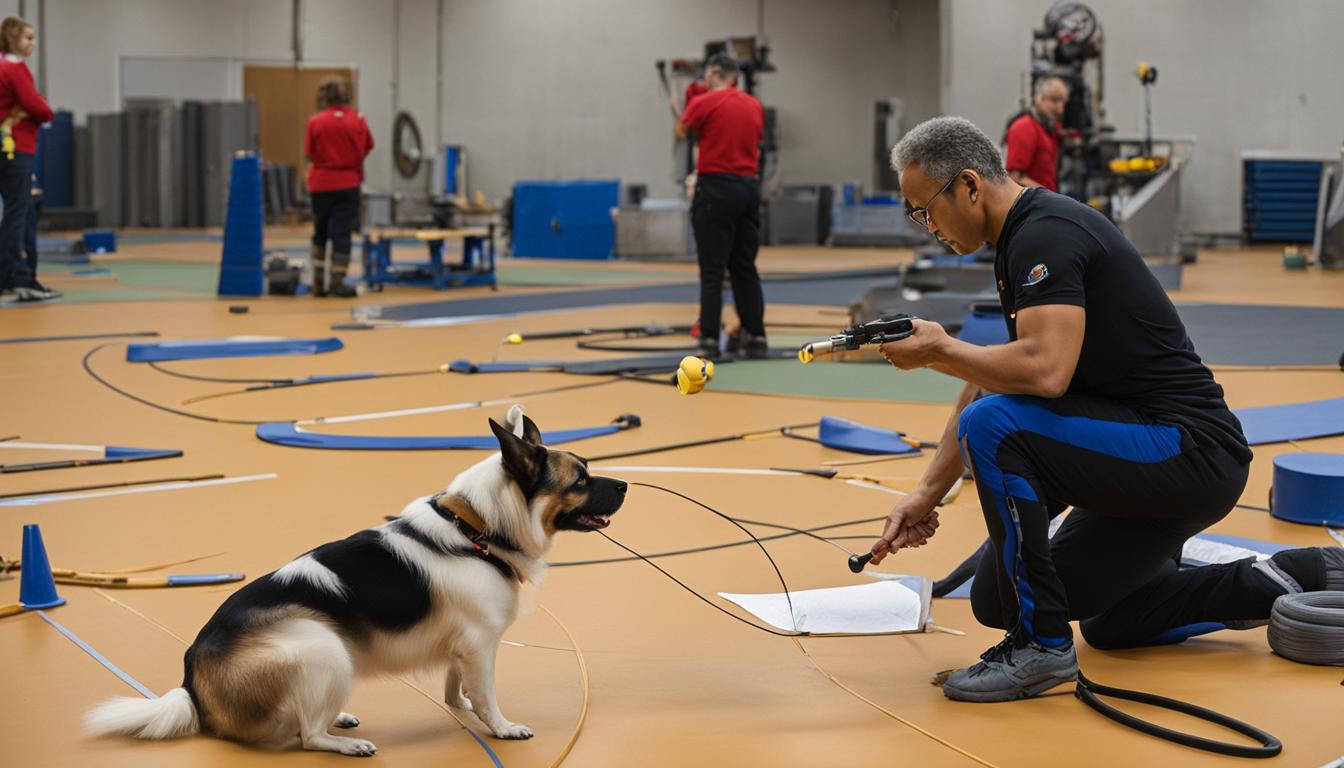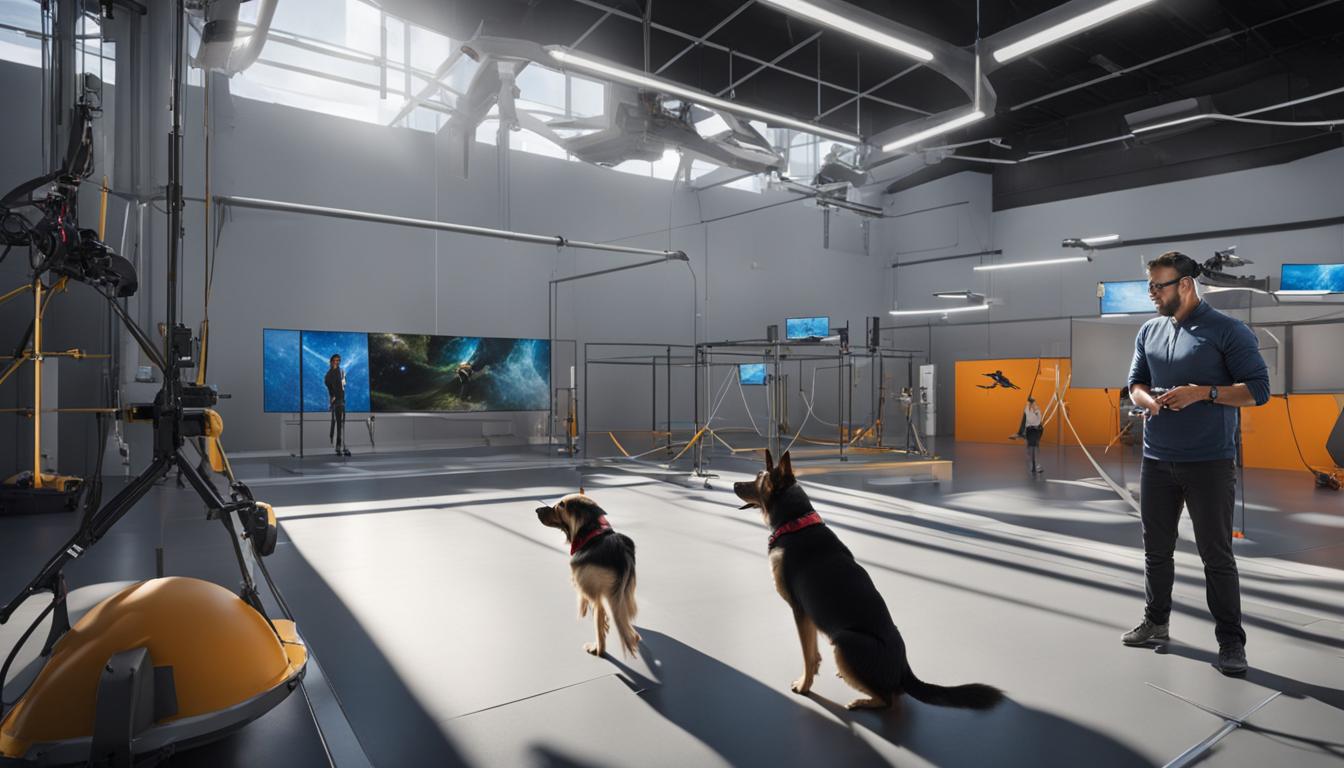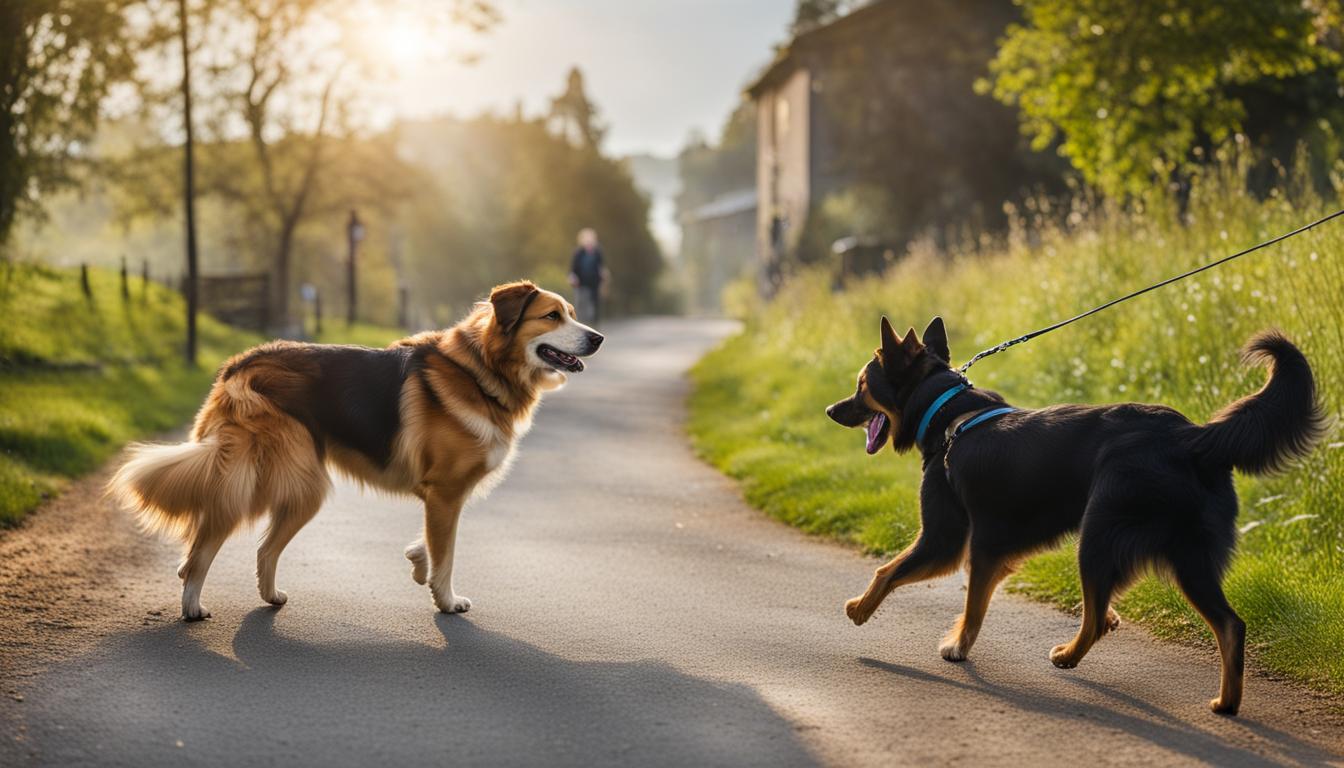Welcome to our article on the fascinating science behind training dogs for specific tasks! Whether it’s guiding the visually impaired, assisting individuals with disabilities, or sniffing out contraband, dogs have proven to be invaluable companions and helpers to humans. In this section, we will delve into the science behind task-specific dog training, exploring the techniques and principles that make it all possible.
Key Takeaways
- Positive reinforcement training, based on the science of animal learning, is highly effective for training dogs.
- Operant conditioning, a form of trial-and-error learning, plays a key role in training dogs.
- Trainers who focus on rewards rather than punishments create a positive training experience for dogs.
- Training techniques for specialized tasks have evolved over time, incorporating behaviorist principles and positive reinforcement.
- Clicker training has revolutionized modern dog training, allowing for immediate reinforcement of correct behavior.
The History and Training of Protection/Apprehension Dogs
Dogs have been working alongside humans for thousands of years, playing various roles such as shepherding, hunting, and even serving in wars. Throughout history, training manuals and procedures for working dogs have evolved, with significant advancements occurring in the 20th century. One specific category of working dogs is protection/apprehension dogs, which are utilized in roles such as sentinel, tracking, protection, and detection work. The history of training these dogs can be traced back to ancient Greece, but it was Colonel Konrad Most’s influential manual, “Training Dogs: A Manual,” published in 1910, that became a valuable resource for training military and law enforcement dogs.
In more recent years, training techniques for specialized tasks like search and rescue have continued to evolve. These techniques now incorporate behaviorist principles, positive reinforcement, and reinforcement schedules. The aim is to improve training practices for working dogs in the twenty-first century, ensuring they are prepared for their specific service tasks.
Training protocols for working dogs, including protection/apprehension dogs, have become more refined and specialized over time. These protocols focus on building a strong bond and trust between the dog and handler, as well as leveraging positive reinforcement to motivate and shape desired behaviors. By using these techniques, trainers can effectively train dogs for specific service tasks, such as search and rescue operations, and ensure they are equipped to perform their duties efficiently and reliably.

Table: Evolution of Training Techniques for Protection/Apprehension Dogs
| Period | Training Techniques |
|---|---|
| Ancient Greece | Basic obedience training with a focus on tracking and protection |
| 20th Century | Introduction of Colonel Konrad Most’s manual and reinforcement-based training methods |
| Modern Era | Behaviorist principles, positive reinforcement, and specialized training protocols for specific service tasks |
As we continue to learn more about dog behavior and the science of training, the techniques for training protection/apprehension dogs will likely continue to evolve. Emphasizing positive reinforcement and a strong bond between dog and handler will always be key elements in their specialized task training.
The Rise of Assistance Dogs and Their Training Techniques
Assistance dogs, including guide dogs, hearing dogs, and service dogs, play a crucial role in supporting individuals with disabilities. The training of assistance dogs has its roots in early guide dog schools, which opened in the early 20th century. The Seeing Eye, the first guide dog school in the United States, introduced innovative training techniques that emphasized socialization, rapport building between dog and handler, and early exposure to a wide range of environmental features. Early training involved puppy raiser programs, where volunteers would raise and provide basic obedience training to puppies. Professional training, conducted by experienced instructors, would occur once the dogs reached adolescence. These comprehensive training programs continue to be standard practice in the guide and assistance dog industry, with a focus on positive reinforcement and the development of a strong bond between dog and handler.
Preparing dogs for therapy work is a specialized training area within the assistance dog field. Therapy dogs visit hospitals, nursing homes, and schools, providing companionship and support to people in need. These dogs require customized training to ensure they are comfortable and well-behaved in different environments. Training protocols for therapy dogs often include obedience training, exposure to various stimuli, and role-specific exercises. Dogs are trained to remain calm and gentle, maintaining steady behavior in potentially stressful situations. The specialized training of therapy dogs allows them to bring comfort and joy to individuals in challenging circumstances.
Role-specific training exercises play a vital role in preparing assistance dogs for their specific tasks. For example, a hearing dog may be trained to recognize and respond to specific sounds, while a service dog may learn to perform tasks such as retrieving objects, opening doors, or providing stability during mobility. These exercises are designed to enhance the natural abilities of the dog and address the specific needs of the individual they are assisting. Role-specific training ensures that assistance dogs are well-equipped to perform their tasks reliably and efficiently, empowering individuals with disabilities to live more independent and fulfilling lives.
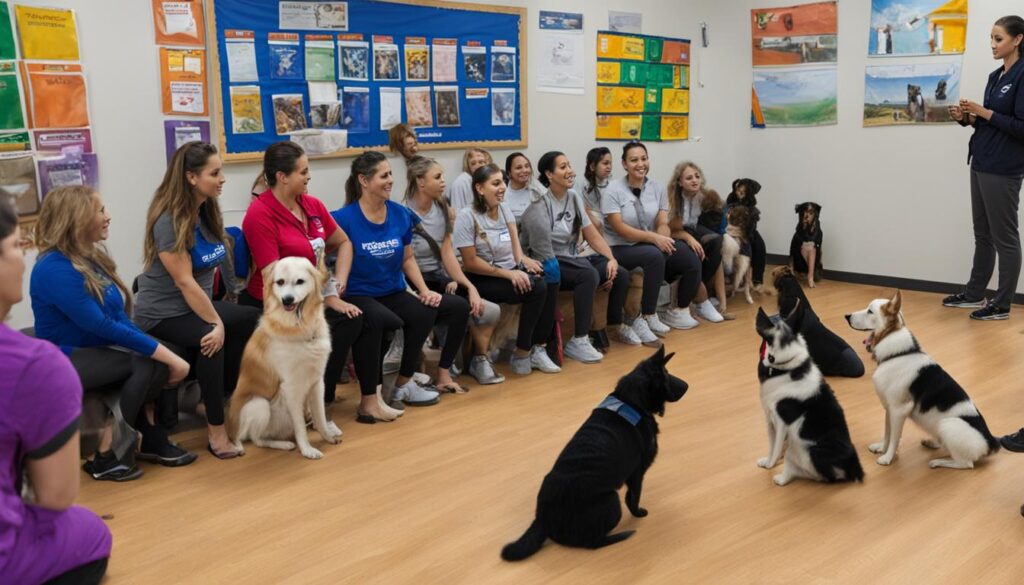
Training Protocols for Therapy Dogs:
| Training Component | Description |
|---|---|
| Obedience Training | Teaching dogs basic commands such as sit, stay, and heel to ensure they are well-behaved and responsive to handler cues. |
| Behavioral Socialization | Exposure to various people, places, and situations to promote confidence, adaptability, and calm behavior in different environments. |
| Therapeutic Environment Simulation | Simulating therapy settings to acclimate dogs to the sights, sounds, and interactions they may encounter during therapy visits. |
| Role-Specific Exercises | Training dogs to perform specific tasks relevant to their role, such as providing comfort, support, or assistance to individuals in need. |
| Distraction Training | Teaching dogs to focus on their handlers and maintain calm behavior even in distracting or potentially stressful situations. |
“Training protocols for therapy dogs often include obedience training, exposure to various stimuli, and role-specific exercises.”
The training of assistance dogs continues to evolve, incorporating new techniques and methodologies to enhance the effectiveness and efficiency of training programs. By customizing training for therapy work and focusing on role-specific exercises, trainers ensure that assistance dogs are well-prepared for their tasks and can provide the necessary support to individuals with disabilities. The bond between assistance dogs and their handlers is built on trust, communication, and mutual understanding, enabling these remarkable animals to transform lives and make a positive impact in our communities.
The Influence of Clicker Training on Modern Dog Training
Clicker training has revolutionized modern dog training, introducing a powerful tool that enhances communication between trainers and dogs. By using a clicker as a marker or cue, trainers can provide immediate feedback to dogs, reinforcing desired behaviors and speeding up the learning process. This method relies on positive reinforcement, rewarding dogs with treats or praise when they exhibit the desired behavior.
One of the key advantages of clicker training is its precision. The clicker serves as a distinct sound that tells the dog exactly which behavior is being rewarded. This allows for clear communication, eliminating any confusion or ambiguity. Dogs quickly learn to associate the clicker with positive outcomes, motivating them to repeat the behavior that earned the click.
“Clicker training is a game-changer. It’s amazing how quickly dogs pick up on the connection between the click and the reward. It’s like they can read our minds!” – Sarah, professional dog trainer
Clicker training has proven to be highly effective in developing skills for service dogs. These dogs undergo rigorous training to perform specialized tasks that assist individuals with disabilities. By using clicker training techniques, trainers can shape and refine complex behaviors, such as alerting a diabetic owner to changes in blood sugar levels or providing support to individuals with post-traumatic stress disorder.
The influence of clicker training extends beyond service dogs. It is also widely used in training dogs for emotional support roles. These dogs provide comfort and companionship to individuals struggling with mental health challenges. Clicker training enables trainers to teach these dogs specific tasks, such as deep pressure therapy or interrupting anxiety or panic attacks, while maintaining a strong bond and positive relationship.
| Benefits of Clicker Training | Applications |
|---|---|
| Enhances communication between trainers and dogs | Service dog training |
| Precise feedback for desired behaviors | Emotional support dog training |
| Speeds up the learning process | |
| Can be used for complex behaviors |
Clicker training has become a staple in modern dog training, empowering trainers to effectively shape behaviors and enhance the partnership between dogs and their handlers. It continues to be embraced and celebrated for its positive and humane approach to training dogs for a wide range of roles and purposes.
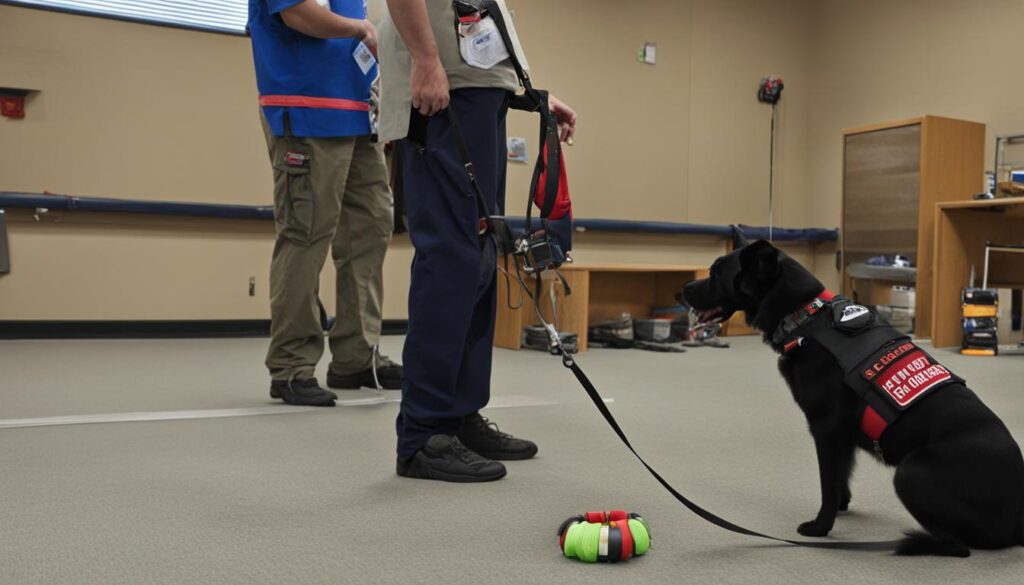
Conclusion
The science of training dogs for specific tasks has seen significant advancements in recent years, thanks to the use of positive reinforcement techniques and specialized training protocols. By focusing on rewards and positive reinforcement, trainers create a positive training experience for dogs, strengthening their bond with their trainers and developing the skills needed for specialized tasks.
Whether it’s training dogs for medical alert tasks or providing support in search and rescue operations, the science of dog training continues to evolve. Trainers now have a better understanding of how to prepare working dogs for their specific roles, ensuring they can assist humans in a variety of ways.
Specialized task training for working dogs is crucial in equipping them with the necessary skills and behaviors to perform their duties effectively. With the use of markers like the clicker, trainers can provide immediate feedback to reinforce correct behaviors. This positive reinforcement approach has revolutionized modern dog training and is widely used in various fields, including training dogs for medical alert tasks.
As the science of dog training continues to progress and evolve, trainers are better equipped to prepare working dogs for their specialized roles. Through the application of positive reinforcement techniques and specialized training protocols, dogs are not only trained for specific tasks but also develop a strong bond with their handlers. This ensures that they can effectively assist humans in a variety of ways, making them invaluable companions and assistants.
FAQ
What is positive reinforcement training?
Positive reinforcement training is a highly effective method for training dogs. It involves rewarding dogs for correct behavior using toys, games, or treats as incentives.
What is operant conditioning?
Operant conditioning is a form of trial-and-error learning that plays a key role in training dogs. It focuses on associating behavior with its consequences, increasing behaviors with pleasant consequences (reinforcement) and decreasing behaviors with unpleasant consequences (punishment).
What are the four quadrants of operant conditioning?
The four quadrants of operant conditioning are positive reinforcement, positive punishment, negative reinforcement, and negative punishment.
Which techniques are the most effective in positive reinforcement training?
Positive reinforcement and negative punishment are the most effective techniques in positive reinforcement training. Trainers who focus on rewards rather than punishments create a positive training experience for dogs.
What is the history of working dogs?
Dogs have been working alongside humans for thousands of years, with roles varying from shepherding to assisting in hunting and even serving in wars.
What are some important training advancements for working dogs?
Significant advancements in training manuals and procedures for working dogs occurred in the 20th century. Col. Konrad Most’s “Training Dogs: A Manual,” published in 1910, became an influential resource for training military and law enforcement dogs.
How have training techniques evolved for specialized tasks like search and rescue?
Training techniques for specialized tasks like search and rescue have evolved, incorporating behaviorist principles, positive reinforcement, and reinforcement schedules.
What roles do assistance dogs play?
Assistance dogs, including guide dogs, hearing dogs, and service dogs, play a crucial role in supporting individuals with disabilities.
What are some key components of assistance dog training?
Assistance dog training emphasizes socialization, rapport building between dog and handler, and early exposure to a wide range of environmental features.
How has clicker training revolutionized modern dog training?
Clicker training, popularized by Karen Pryor in the 1960s, has revolutionized modern dog training by allowing for immediate reinforcement of correct behavior using a clicker as a marker or cue.
Can clicker training be applied to other animals?
Yes, clicker training can be applied to various animals, including dogs, cats, and even difficult teenagers.
What are the advancements in task-specific dog training?
Advancements in task-specific dog training include positive reinforcement techniques, specialized training protocols, and the introduction of markers like the clicker.

